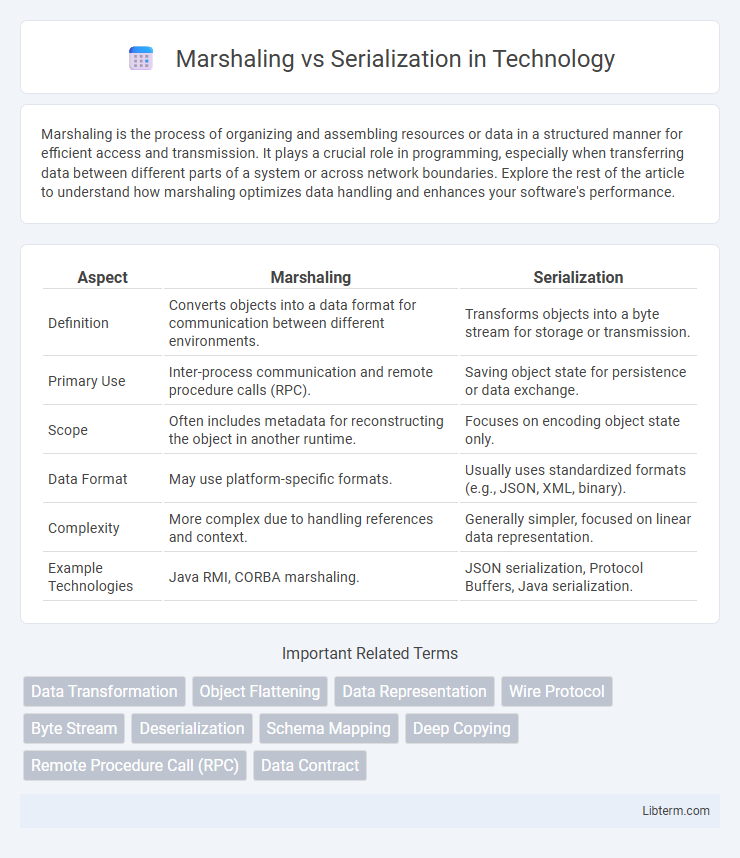Marshaling is the process of organizing and assembling resources or data in a structured manner for efficient access and transmission. It plays a crucial role in programming, especially when transferring data between different parts of a system or across network boundaries. Explore the rest of the article to understand how marshaling optimizes data handling and enhances your software's performance.
Table of Comparison
| Aspect | Marshaling | Serialization |
|---|---|---|
| Definition | Converts objects into a data format for communication between different environments. | Transforms objects into a byte stream for storage or transmission. |
| Primary Use | Inter-process communication and remote procedure calls (RPC). | Saving object state for persistence or data exchange. |
| Scope | Often includes metadata for reconstructing the object in another runtime. | Focuses on encoding object state only. |
| Data Format | May use platform-specific formats. | Usually uses standardized formats (e.g., JSON, XML, binary). |
| Complexity | More complex due to handling references and context. | Generally simpler, focused on linear data representation. |
| Example Technologies | Java RMI, CORBA marshaling. | JSON serialization, Protocol Buffers, Java serialization. |
Introduction to Marshaling and Serialization
Marshaling and serialization both involve transforming objects into a format suitable for storage or transmission. Marshaling typically refers to the process of preparing and packaging objects, including complex data types and references, for remote procedure calls (RPC) or interprocess communication (IPC). Serialization, on the other hand, converts objects into a byte stream or standardized format, such as JSON or XML, enabling data persistence or network communication.
Understanding Data Transformation in Programming
Marshaling and serialization both refer to transforming data structures into a format suitable for storage or transmission, but marshaling emphasizes preparing complex objects for remote procedure calls by packaging their state and type information. Serialization primarily involves converting objects into a byte stream or JSON/XML format for persistence or communication, focusing on data integrity and format adherence. Understanding these processes is crucial for efficient data exchange, especially in distributed systems and inter-process communication where accurate reconstruction of object states is required.
What is Marshaling?
Marshaling is the process of transforming the memory representation of an object to a data format suitable for storage or transmission across network boundaries. It enables seamless communication between different programming environments by converting complex data structures into a standardized format. Marshaling plays a critical role in distributed systems, facilitating remote procedure calls and inter-process communication.
What is Serialization?
Serialization is the process of converting an object's state into a byte stream to enable its storage or transmission across a network. This technique ensures that complex data structures such as objects, arrays, or graphs can be easily saved to a file, sent over a communication channel, or stored in databases. Serialization formats include JSON, XML, and binary, which facilitate interoperability between different systems and programming environments.
Key Differences Between Marshaling and Serialization
Marshaling involves transforming objects into a format suitable for transmission over a network or between processes, often including metadata for reconstruction, whereas serialization focuses primarily on converting objects into a byte stream for storage or communication. Marshaling is tightly coupled with remote procedure calls (RPC) and supports inter-process communication by handling complex object graphs, while serialization is generally used for persisting object states or transferring data within the same environment. Key differences include marshaling's emphasis on network communication and format compatibility, contrasted with serialization's goal of efficient storage and retrieval.
Use Cases: When to Use Marshaling vs Serialization
Marshaling is ideal for remote procedure calls (RPC) where objects need to be transmitted between different environments while preserving runtime type information. Serialization is best suited for data storage, caching, and transmitting data over networks in a platform-independent format like JSON or XML. Use marshaling when working within homogeneous systems requiring precise object reconstruction, and serialization when interoperability and lightweight data exchange are priorities.
Popular Libraries and Tools for Marshaling and Serialization
Popular libraries for serialization include Newtonsoft.Json and System.Text.Json for JSON serialization in .NET, along with Google's Protocol Buffers for binary serialization. Marshaling tools are commonly integrated into remote procedure call (RPC) frameworks like gRPC, which uses Protocol Buffers to serialize structured data between clients and servers. XMLSerializer and DataContractSerializer in .NET also provide robust mechanisms for marshaling by converting objects into XML format suitable for data exchange.
Performance Comparison: Marshaling vs Serialization
Marshaling and serialization both convert objects into a transferable format, but serialization typically offers faster processing due to its streamlined binary or JSON output, making it ideal for network transmission and storage. Marshaling, while more flexible by supporting custom protocol implementations and deep copying, often incurs higher CPU overhead and latency because of the added complexity in managing object references and metadata. Performance benchmarks show serialization excels in scenarios demanding high throughput and low latency, whereas marshaling better suits applications needing precise control over data representation and object lifecycle.
Security Considerations in Data Conversion
Marshaling and serialization both transform data structures into a transmittable format, but marshaling often involves direct memory pointers, increasing the risk of pointer-based attacks and data leakage if not properly handled. Serialization typically converts objects into string or byte streams, requiring strict validation and sanitization to prevent injection attacks, deserialization vulnerabilities, and unauthorized code execution. Implementing robust input validation, using secure libraries, and enforcing strict type constraints are critical security measures in both processes to mitigate risks during data conversion.
Best Practices for Efficient Data Handling
Efficient data handling requires choosing marshaling for in-memory data transformation and serialization for persistent storage or network transmission. Best practices include minimizing data size by excluding redundant fields, using compact binary formats like Protocol Buffers or MessagePack for serialization, and implementing version control to maintain compatibility. Properly managing object references during marshaling reduces overhead and ensures faster processing in distributed systems.
Marshaling Infographic

 libterm.com
libterm.com